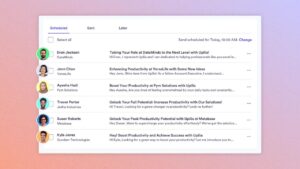What are Outbound Sales?
Outbound sales refer to the traditional sales practice of reaching out to leads to make contact, initiate communication, and get them interested in your product. Every sales rep helps drive outbound sales through cold calls and emails. Generating new leads is essential for any business to build a healthy sales pipeline, so knowing how to successfully generate outbound sales is important.
Outbound vs. Inbound Sales
Both outbound and inbound sales focus on nurturing leads and moving them through the sales funnel, but there are important differences to understand.
Outbound sales are made by sales reps who conduct external outreach.
Inbound sales, in contrast, refer specifically to attracting leads. Instead of reaching out to them, the leads are brought in through various lead-generation tactics.
Why are Outbound Sales Important?
Without outbound sales, a prospect pool would quickly dwindle, and there’d be no one to sell to. Conducting research, contacting people, and building relationships with them are needed to hit sales goals.
Outbound sales are essential for any sales team. Every company should have an outbound sales strategy that outlines best practices, what types of leads to target, and how to effectively move people through the sales funnel.
Outbound Sales Process
Every company will have a different outbound sales strategy depending on its specific goals. However, they all follow the same basic steps:
- Sales Prospecting. Always start with research when sales prospecting. It’s important to ensure you’re reaching out to individuals that match your ideal customer profile (ICP). Leverage tools like LinkedIn Sales Navigator or social media, check out their company’s website and find any other details that will help determine if they’re a good fit. In addition, you can use an automated B2B sales prospecting tool and let AI help with the heavy lifting.
- Cold outreach. Outbound sales require cold outreach in the form of cold calls or emails. Video emails are recommended for cold outreach because they’re more effective than text-based emails. While reaching out, tell your leads how you and your product will help their business and personalize the conversation.
- Demos and sales pitches. Once a lead is qualified, it’s time to truly sell them on your product. Put together a sales pitch that caters to their needs and demo your product. Again, you can use videos to help with product demos to show them exactly how everything works.
- Closing a deal. After negotiating and addressing any sales objections, it’s time to close out the deal. Always confirm the details of a sale with their decision maker before a final offer is sent through. You can use a digital sales room to collaborate with all stakeholders and organize related documents, links and videos in one centralized location.
- Ongoing customer support. After a sale is made, follow up with your customer to ensure they have everything they need, understand the product, and are satisfied.

 Spend less time hunting leads and more time hitting quota with Vidyard Prospector. Learn More
Spend less time hunting leads and more time hitting quota with Vidyard Prospector. Learn More Tips for Conducting Outbound Sales
Conducting outbound sales can be time-consuming and exhausting. It requires fine-tuned skills, sales experience, and a solid strategy outlining goals and metrics, as well as resources to help guide the sales team.
Following these tips will help ensure success:
- Use your ideal customer profile. When prospecting, ensure you’re targeting the right people. There’s no point wasting time sending emails to individuals who aren’t a good fit for your product.
- Make sure outreach is engaging. When you do reach out to sales leads, make sure your message is engaging. Send a video introducing yourself; this will grab their attention and increase the likelihood of getting a response.
Give sales reps the tools and resources they need. Sales aren’t linear; expectations and best practices are always changing. What works for one sales lead won’t work for another. It’s essential that sales reps complete ongoing training to stay up to date on the latest trends. Following sales experts online and engaging with their content is a great place to start.
